|
Battle of Port Republic, Virginia
Shenandoah Valley Campaign and Civil War
Battle of Port Republic
Other Names: None
Location: Rockingham County
Campaign: Jackson's Shenandoah Valley Campaign (1862)
Date(s): June 9, 1862
Principal Commanders: Brig. Gen. Erastus Tyler [US]; Maj. Gen.
Thomas J. Jackson [CS]
Forces Engaged: 9,500 total (US 3,500; CS 6,000)
Estimated Casualties: 1,818 total (US 1,002; CS 816)
Result(s): Confederate victory.
Description: Maj. Gen. T.J. Jackson concentrated his forces east
of the South Fork of the Shenandoah against the isolated brigades of Tyler and Carroll of Shields’s division, Brig.
Gen. Erastus Tyler commanding. Confederate assaults across the bottomland were repulsed with heavy casualties, but a flanking
column turned the Union left flank at the Coaling. Union counterattacks failed to reestablish the line, and Tyler was forced
to retreat. Confederate forces at Cross Keys marched to join Jackson at Port Republic burning the North River Bridge behind
them. Frémont’s army arrived too late to assist Tyler and Carroll and watched helplessly from across the rain-swollen
river. After these dual defeats at Cross Keys and Port Republic, the Union armies retreated, leaving Jackson in control of
the upper and middle Shenandoah Valley and freeing his army to reinforce Lee before Richmond.
| Battle of Port Republic Map |

|
| Virginia Civil War Port Republic Battlefield Map |
| Port Republic Civil War Map |
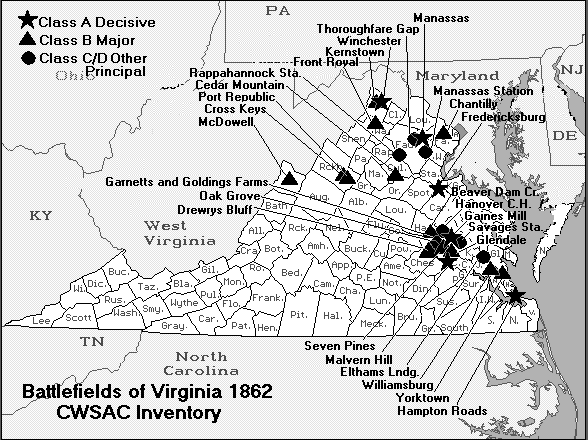
|
| Battle of Port Republic, Virginia, Map |
Setting the Stage: During the night of June 8–9,
1862, Brig. Gen. Charles S. Winder's Stonewall Brigade was withdrawn from its forward position near Bogota (a large house
owned by Gabriel Jones) and rejoined Jackson's division at Port Republic. Confederate pioneers built a bridge of wagons across
the South Fork of the Shenandoah River at Port Republic. Winder's brigade was assigned the task of spearheading the assault
against Union forces east of the river. Brig. Gen. Isaac R. Trimble's brigade and elements of Col. John M. Patton, Jr.'s,
were left to delay Maj. Gen. John C. Frémont's forces at Cross Keys, while the rest of Maj. Gen. Richard S. Ewell's division
marched to Port Republic to be in position to support Winder's attack.
Brig. Gen. Erastus B. Tyler's brigade joined Col. Samuel Carroll's brigade
north of Lewiston on the Luray Road. The rest of Brig. Gen. James Shields's division was strung out along the muddy roads
back to Luray. General Tyler, in command on the field, advanced at dawn of June 9 to the vicinity of Lewiston. He anchored
the left of his line on a battery positioned on the Lewiston Coaling, extending his infantry west along Lewiston Lane to the
South Fork near the site of Lewis's Mill. The right and center were supported by artillery, 16 guns in all.
| Civil War Battle of Port Republic Map |
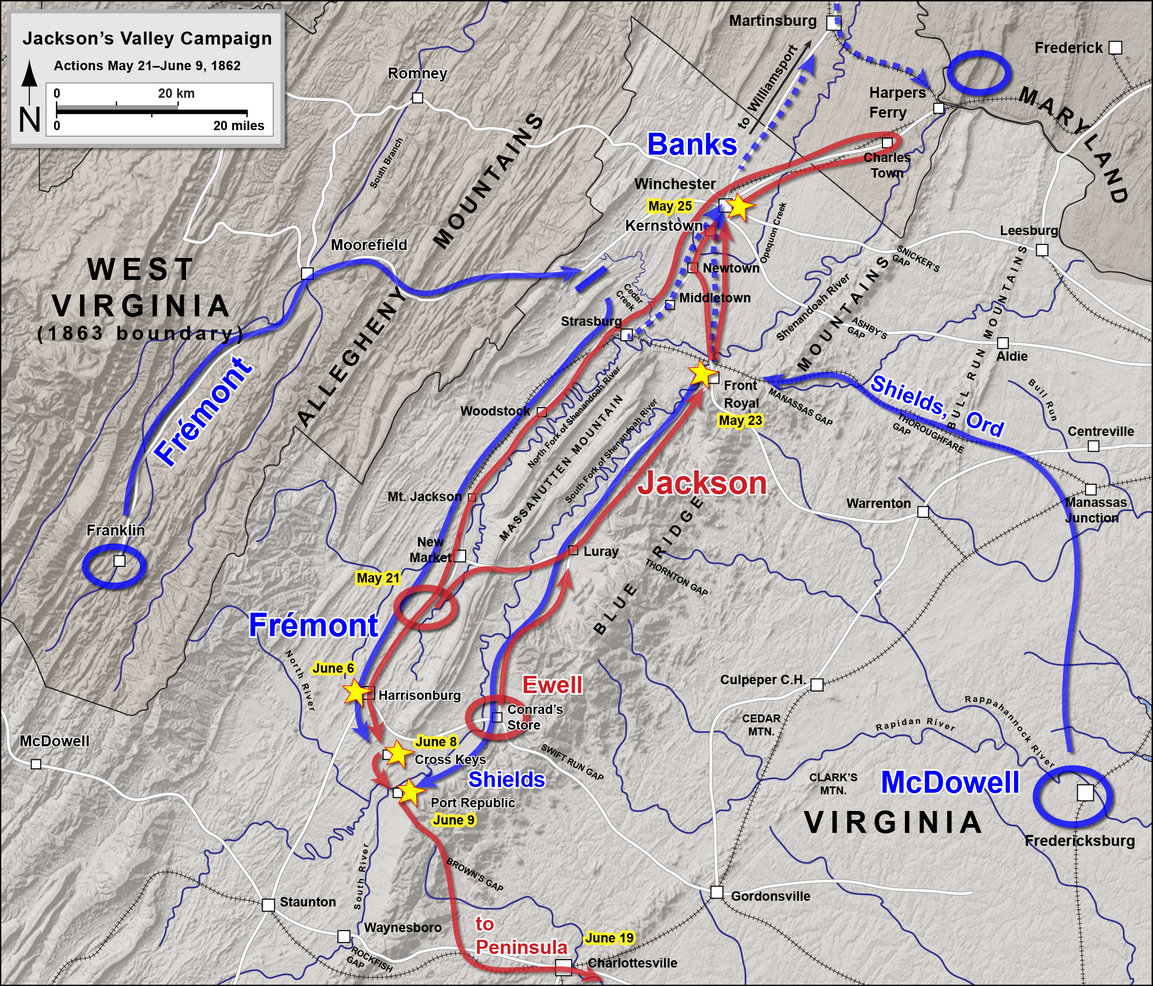
|
| Jackson's Valley Campaign: Front Royal to Port Republic. |
Battle: Winder's brigade crossed the river by 5 a.m. and deployed to attack east across
the bottomland. Winder sent two regiments (2nd Virginia and 4th Virginia) into the woods to flank the Union line and assault
the Coaling. When the main Confederate battle line advanced, it came under heavy fire from the Union artillery and was soon
pinned down. Confederate batteries were brought forward onto the plain but were outgunned and forced to seek safer positions.
Ewell's brigades were hurried forward to cross the river. Seeing the strength of the Union artillery at the Coaling, Jackson
sent Richard Taylor's brigade (including the famed Louisiana Tigers) to the right into the woods to support the flanking column
that was attempting to advance through the thick underbrush.
Winder's brigade renewed its assault on the Union right and center, taking heavy casualties. General Tyler
moved two regiments from the Coaling to his right and launched a counterattack, driving Confederate forces back nearly half
a mile. While this was occurring, the first Confederate regiments probed the defenses of the Coaling, but were repulsed.
| Battle of Port Republic Map |
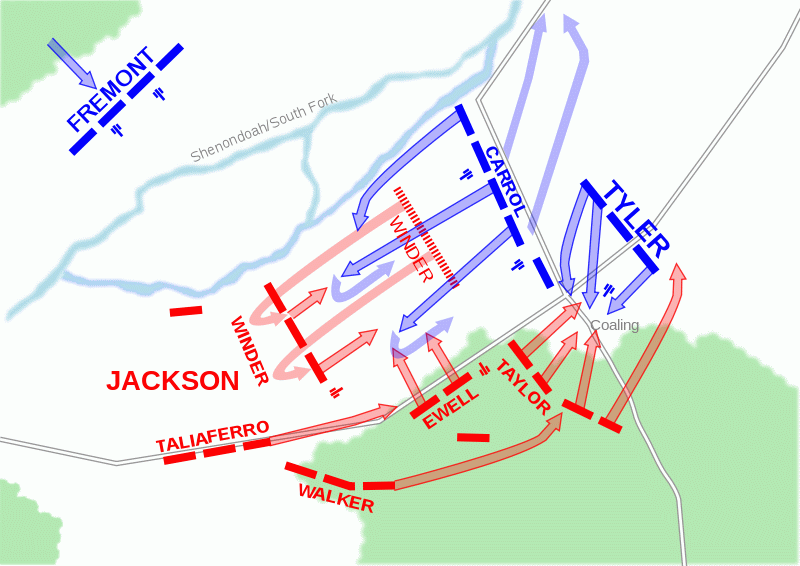
|
| Civil War Virginia Map |
| Civil War Port Republic Battle |
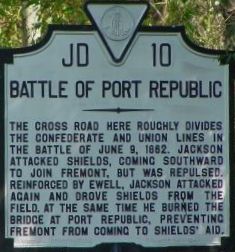
|
| Port Republic Historical Marker |
Finding resistance fiercer than anticipated, Jackson ordered the last of Ewell's forces still north of Port
Republic to cross the rivers and burn the North Fork bridge. These reinforcements began to reach Winder, strengthening his
line and stopping the Union counterattack. Taylor's brigade reached a position in the woods across from the Coaling and launched
a fierce attack, which carried the hill, capturing five guns. Tyler immediately responded with a counterattack, using his
reserves. These regiments, in hand-to-hand fighting, retook the position. Taylor shifted a regiment to the far right to outflank
the Union battle line. The Confederate attack again surged forward to capture the Coaling. Five captured guns were turned
against the rest of the Union line. With the loss of the Coaling, the Union position along Lewiston Lane became untenable,
and Tyler ordered a withdrawal about 10:30 a.m. Jackson ordered a general advance.
William B. Taliaferro's fresh Confederate brigade arrived from Port Republic and pressed the retreating
Federals for several miles north along the Luray Road, taking several hundred prisoners. The Confederate army was left in
possession of the field. Shortly after noon, Frémont's army began to deploy on the west bank of the South Fork, too late to
aid Tyler's defeated command, and watched helplessly from across the rain-swollen river. Frémont deployed artillery on the
high bluffs to harass the Confederate forces. Jackson gradually withdrew along a narrow road through the woods and concentrated
his army in the vicinity of Mt. Vernon Furnace. Jackson expected Frémont to cross the river and attack him on the following
day, but during the night Frémont withdrew toward Harrisonburg.
| Battle of Port Republic Aftermath |
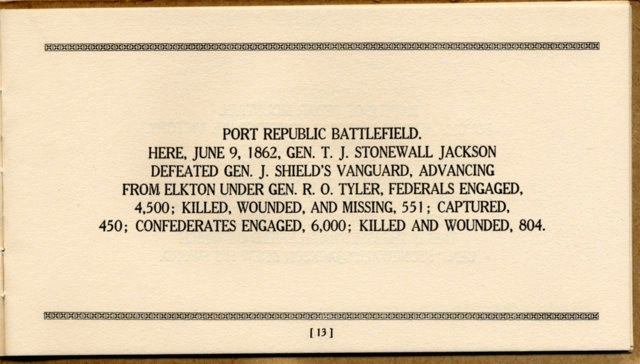
|
| Port Republic Civil War Results |
Aftermath and Analysis: After the dual defeats
at Cross Keys and Port Republic, the Union armies retreated, leaving Jackson in control of the upper and middle Shenandoah
Valley and freeing his army to reinforce Robert E. Lee before Richmond in the Seven Days Battles.
The Battle of Port Republic was fought on June 9, 1862, in Rockingham County, Virginia, as part of Confederate
Army Maj. Gen. Thomas J. "Stonewall" Jackson's campaign through the Shenandoah Valley during the American Civil War. Port
Republic was a fierce contest between two equally determined foes and was the most costly battle fought by Jackson's Army
of the Valley during its campaign. Together, the battles of Cross Keys (fought the previous day) and Port Republic were the
decisive victories in Jackson's Valley Campaign, forcing the Union armies to retreat and leaving Jackson free to reinforce
Gen. Robert E. Lee for the Seven Days Battles outside Richmond, Virginia.
Confederate Army Order of Battle
Department of the Valley
MG Thomas J. Jackson
|
Division |
Brigade |
Regiment
or Other |
|
Jackson's
Division
MG Thomas J. Jackson |
First (Stonewall)
Brigade
BG Charles S. Winder
|
- 2nd Virginia Infantry – Col J. W. Allen
- 4th Virginia Infantry – Col Charles A. Ronald
- 5th Virginia Infantry – Ltc J. H. S. Funk
- 27th Virginia Infantry – Col Andrew J. Grigsby
- 33rd Virginia Infantry – Col John F. Neff
|
|
Second (Campbell’s) Brigade
Col John M. Patton
|
- 21st Virginia Infantry – Ltc R. H. Cunningham
- 42nd Virginia Infantry - Ltc William T. Martin
- 48th Virginia Infantry – Ltc Thomas S. Garnett
- 1st Virginia Battalion – Cpt B. W. Leigh
|
|
Second (Taliaferro's) Brigade
BG William B. Taliaferro
|
- 10th Virginia Infantry - Col E. T. H. Warren
- 23rd Virginia Infantry - Col Alexander G. Taliaferro
- 37th Virginia Infantry - Col Samuel V. Fulkerson
|
|
Artillery |
- Poague's Battery - Cpt William T. Poague
- Wooding's Battery - Cpt George W. Wooding
- Carpenter's Battery - Cpt Joseph Carpenter
|
|
Ewell's
Division
MG Richard S. Ewell |
Second (Steuart's) Brigade
Col W.C. Scott
|
- 1st Maryland Infantry – Col Bradley T. Johnson
- 44th Virginia Infantry – Col W. C. Scott, Maj Cobb
- 52nd Virginia Infantry – Ltc James H. Skinner
- 58th Virginia Infantry - Col Samuel H. Letcher
|
|
Fourth (Elzey's) Brigade
Col James A. Walker
|
- 12th Georgia Infantry - Col Zephaniah T. Conner
- 13th Virginia Infantry - Col James A. Walker
- 25th Virginia Infantry - Ltc Patrick B. Duffy
- 31st Virginia Infantry - Col John S. Hoffman
|
|
Seventh (Trimble's) Brigade
BG Isaac Trimble
|
- 15th Alabama Infantry - Col James Cantey
- 21st Georgia Infantry - Col John T. Mercer
- 16th Mississippi Infantry - Col Carnot Posey
- 21st North Carolina Infantry - Col William W. Kirkland
|
|
Eighth (Taylor's) Brigade
BG Richard Taylor
|
- 6th Louisiana Infantry - Col Isaac G. Seymour
- 7th Louisiana Infantry – Col Harry T. Hays (w),
Maj D. Penn
- 8th Louisiana Infantry - Col Henry B. Kelly
- 9th Louisiana Infantry - Col Leroy A. Stafford
- Wheat’s Battalion (“Louisiana Tigers”)
– Maj C. R. Wheat
|
|
Artillery
Col Stapleton Crutchfield
|
- Brockenbrough’s Battery - Cpt John B. Brockenbrough
- Courtney’s Battery - Cpt A. R. Courtney
- Lusk’s Battery - Cpt John A. M. Lusk
- Raine’s Battery - Cpt Charles I. Raine
- Rice's Battery - Cpt William H. Rice
|
|
Cavalry Brigade
Col Thomas T. Munford
|
- 2nd Virginia Cavalry - Col Thomas T. Munford
- 6th Virginia Cavalry - Col Thomas Flournoy
- Chew's Battery - Cpt R. Preston Chew
|
| Confederate and Union Army Order of Battle Map |
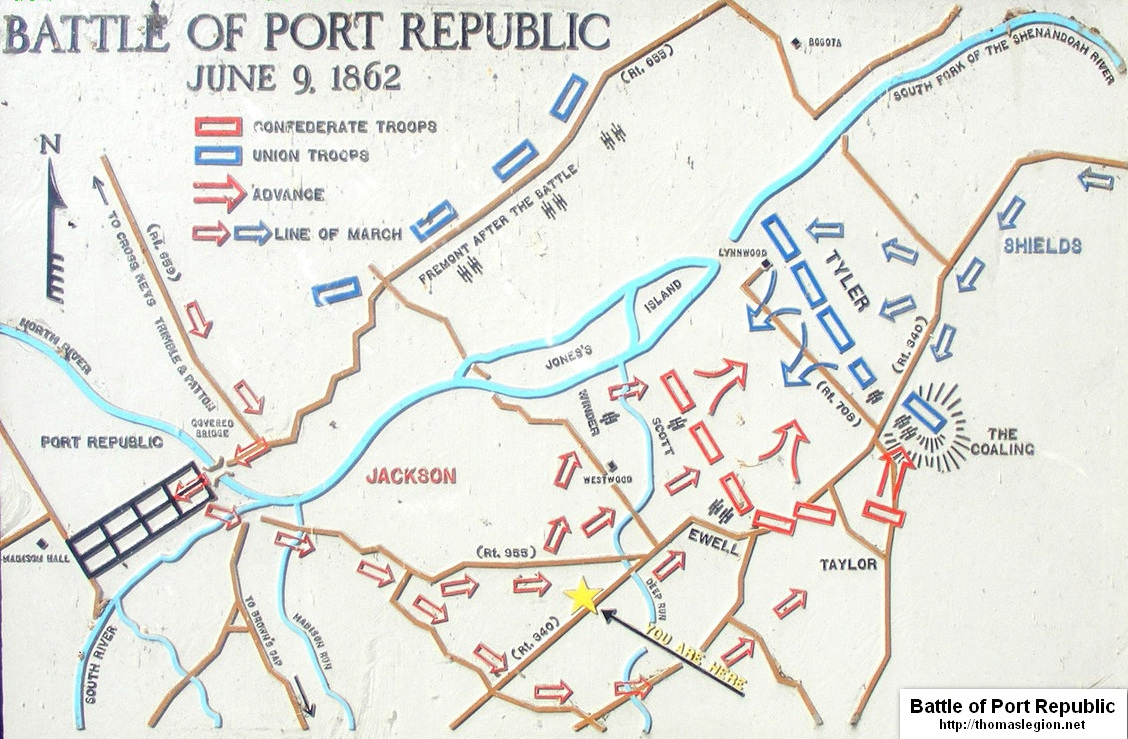
|
| Union and Confederate Forces Battle Map |
Union Army Order of Battle
Department of the Rappahannock
MG Irvin McDowell
(not present)
Forces at Port Republic
BG Erastus B. Tyler
|
Division |
Brigade |
Regiment
or Other |
|
Shield's
Division
BG James Shields (not present) |
Third (Tyler’s)
Brigade
BG Erastus B. Tyler
|
- 7th Indiana Infantry: Col James Gavin
- 7th Ohio Infantry: Ltc William P. Creighton
- 29th Ohio Infantry: Col Louis P. Buckley
- 110th Pennsylvania Infantry: Col William D. Lewis
- 1st West Virginia Infantry: Col Joseph Thoburn
|
|
Fourth (Carroll’s)
Brigade
Col Samuel S. Carroll
|
- 5th Ohio Infantry: Col Samuel H. Dunning
- 66th Ohio Infantry: Col Charles Candy
- 84th Pennsylvania Infantry: Maj Walter Barrett
|
|
Cavalry |
- 1st West Virginia Cavalry: Maj Benjamin F. Chamberlain
|
|
Artillery |
- Battery L, 1st Ohio Artillery: Cpt Lucius N. Robinson
- Battery H, 1st Ohio Artillery: Cpt James F. Huntington
- Battery E, 4th U.S. Artillery: Cpt Joseph C. Clark,
Jr.
|
Sources: National Park Service; Library of Congress; Civil War Trust; Cozzens,
Peter. Shenandoah 1862: Stonewall Jackson's Valley Campaign. Chapel Hill: University of North Carolina Press, 2008. ISBN 978-0-8078-3200-4;
Krick, Robert K. Conquering the Valley: Stonewall Jackson at Port Republic. New York: William Morrow & Co., 1996. ISBN
0-688-11282-X; Tanner, Robert G. Stonewall in the Valley: Thomas J. "Stonewall" Jackson's Shenandoah Valley Campaign, Spring
1862. Garden City, NY: Doubleday, 1976. ISBN 978-0-385-12148-4; Official Records of the Union and Confederate Armies; Jackson's
Valley Campaign: Front Royal to Port Republic, Courtesy Hal Jespersen, cwmaps.com.
|

